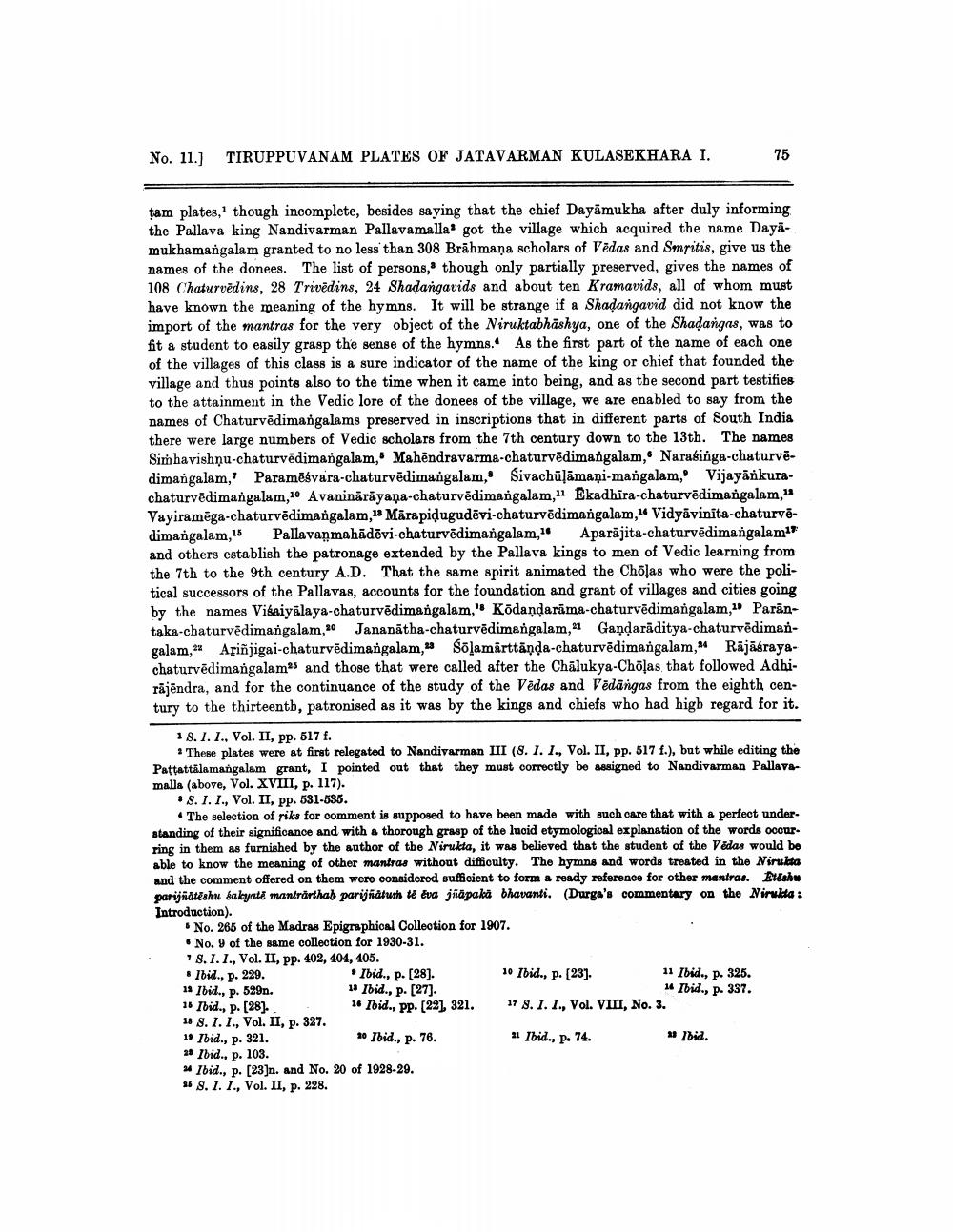________________
No. 11.) TIRUPPUVANAM PLATES OF JATAVARMAN KULASEKHARA I.
tam plates, though incomplete, besides saying that the chief Dayāmukha after duly informing the Pallava king Nandivarman Pallavamalla got the village which acquired the name Dayamukhamangalam granted to no less than 308 Brāhmaṇa scholars of Vēdas and Smritis, give us the names of the donees. The list of persons, though only partially preserved, gives the names of 108 Chaturvēdins, 28 Trivedins, 24 Shadangavids and about ten Kramavids, all of whom must have known the meaning of the hymns. It will be strange if a Shadangavid did not know the import of the mantras for the very object of the Niruktabhäshya, one of the Shadangas, was to fit a student to easily grasp the sense of the hymns. As the first part of the name of each one of the villages of this class is a sure indicator of the name of the king or chief that founded the village and thus points also to the time when it came into being, and as the second part testifies to the attainment in the Vedic lore of the donees of the village, we are enabled to say from the names of Chaturvēdimangalams preserved in inscriptions that in different parts of South India there were large numbers of Vedic scholars from the 7th century down to the 13th. The names Simhavishnu-chaturvēdimangalam, Mahendravarma-chaturvēdimangalam, Narasinga-chaturvēdimangalam. Paramēsvara-chaturvēdimangalam, Sivachūlāmaņi-mangalam, Vijayārkurachaturvēdimangalam,1o Avaninäräyana-chaturvēdimangalam," Ekadhira-chaturvēdimangalam, Vayiramēga-chaturvēdimangalam, Mārapidugudēvi-chaturvēdimangalam, Vidyāvinita-chaturvedimangalam,15 Pallavanmahādēvi-chaturvēdimangalam," Aparajita-chaturvēdimangalam." and others establish the patronage extended by the Pallava kings to men of Vedic learning from the 7th to the 9th century A.D. That the same spirit animated the Chöļas who were the political successors of the Pallavas, accounts for the foundation and grant of villages and cities going by the names Vibiyalaya-chaturvēdimangalam," Ködandarama-chaturvēdimangalam, Parantaka-chaturvedimangalam, 0 Jananātha-chaturvēdimangalam," Gandariditya-chaturvēdimangalam, au Ariñjigai-chaturvēdimangalam, Solamārttända-chaturvēdimangalam, Räjābrayachaturvēdimangalam and those that were called after the Chālukya-Cholas that followed Adhirājēndra, and for the continuance of the study of the Vēdas and Vēdāngas from the eighth century to the thirteenth, patronised as it was by the kings and chiefs who had higb regard for it.
18.1. 1., Vol. II, pp. 517 f.
a These plates were at first relegated to Nandivarman III (8. 1. 1., Vol. II, pp. 517 1.), but while editing the Pattattálamangalam grant, I pointed out that they must correctly be assigned to Nandivarman Pallavamalla (above, Vol. XVIII, p. 117).
. 8.1.1., Vol. II, pp. 531-535.
• The selection of riks for comment is supposed to have been made with such care that with a perfect understanding of their significance and with a thorough grasp of the lucid etymologioal explanation of the words ooour. ring in them as furnished by the author of the Ninukta, it was believed that the student of the Vedas would be able to know the meaning of other mantras without difficulty. The hymns and words treated in the Ninulta and the comment offered on them were considered sufficient to form a ready reference for other mantras. Elahu parijatiahne Sakyatt mantarthad parijatur te eva jäpaka bhavanti. (Durga's commentary on the Nirulda: Introduction).
.No. 265 of the Madras Epigraphical Collection for 1907. • No. 9 of the same collection for 1930-31. 18.1.1., Vol. II, pp. 402, 404, 405. . lbid., p. 229. Ibid., p. [28]. 10 Ibid., P. [23].
11 Ibid., p. 325. 11 Ibid., p. 529n. 11 Ibid., p. [27).
14 Ibid., p. 337. 18 Ibid., p. [28]. . ** Ibid., PP. [22], 321. 17 8. 1. 1., Vol. VIII, No. 3. 18 8.1.1., Vol. II, p. 327. 16 Ibid., p. 321.
20 Ibid., p. 76. a1 Ibid., p. 74.
1 lbid. 21 Ibid., p. 103. M Ibid., p. [23]n. and No. 20 of 1928-29. 1 8. 1. 1., Vol. II, p. 228.




